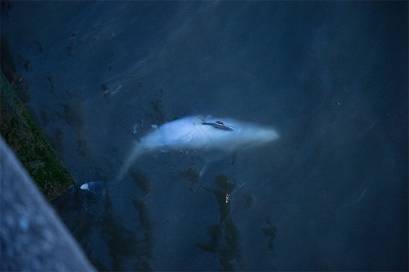The dolphin that recently appeared in the River Dee in Wales was fortunate to survive. Being a marine species, it was not used to a fresh water environment and very nearly perished after beaching on a sand bank. Fortunately, the RNLI were able to rescue the animal and return it to the sea where it could more easily hunt and find food.
Not all marine cetaceans that find themselves caught upriver are so fortunate. On Tuesday 27 August, at around 8.30pm, Greg Fonne took the following image from the Thames embankment, just east of Tower Bridge.
 The animal in question appears to be a Harbour Porpoise, or Phocoena phocoena.
The animal in question appears to be a Harbour Porpoise, or Phocoena phocoena.
The Cetacean Strandings Investigation Programme (of which we are a part) records around 300 cases of dead Harbour Porpoise on UK coasts each year. On many occasions, we collect the bodies, and take them for post-mortem examination. This is because we want to find out the cause of death, as well as monitoring levels of disease, toxins and pollutants, parasites, and all kinds of things that can only be discovered from taking a look inside the animal.
This year marks the 100th anniversary of the Museum's whale and dolphin strandings monitoring programme. This porpoise found in the Thames will add to our data which shows us how populations are changing.
Cetacean statistics
Our data shows that in recent decades, the number of reports has increased dramatically. This could be explained by an increase in strandings, as well as an increase in communication methods and their ease of use and, of course, by the ever increasing human population with their eyes on the coast.
While the death of these beautiful animals seems a somewhat tragic event, an increase in the number of strandings is not necessarily a bad thing. It is evidence that the animals are living in UK waters, and surviving to breeding age. Through our work, which is government funded, we can keep watch on the effects of human behaviours on cetacean species.
Please help us to continue our work by spreading the word about the UK Cetacean Strandings Investigation Programme, and by following us on twitter @WhaleStrandings.
Find out more about the Museum's Cetacean strandings project
Meet us in person at the Oceans Station at Science Uncovered on Friday 27 September


